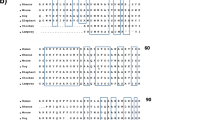Abstract
Serum amyloid A (SAA) is an acute-phase reactant and precursor to amyloid A protein, the major constituent of the fibril deposits of reactive amyloidosis. The factors determining whether the 104-amino acid SAA molecule is converted into the 76-amino acid amyloid A protein and deposited as fibrils are not known. As an initial step toward investigating the possibility that a particular primary structure of SAA is involved in amyloid formation, we have cloned and determined the nucleotide sequence of human SAA-specific cDNAs. The first clone, selected using an oligonucleotide probe, was shown to encode the signal peptide and amino-terminal region of SAA. The cDNA of this clone served as probe in the selection of two distinct, full-length SAA cDNAs, initially differentiated by the presence (pSAA21) or absence (pSAA82) of a PstI site in the coding sequence. The complete nucleotide sequence of pSAA82 cDNA was determined. Since there appear to be multiple human SAA alleles, it is conceivable that their differential expression is important to amyloid formation.
Similar content being viewed by others
References
Anders, R. F., Natvig, J. B., Sletten, K., Husby, G., and Nordstoga, K. (1977). Amyloid-related serum protein SAA from three animal species: Comparison with human SAA.J. Immunol. 118229.
Chirgwin, J. M., Przybyla, A. E., MacDonald, R. J., and Rutter, W. J. (1979). Isolation of biologically active ribonucleic acid from sources enriched in ribonuclease.Biochemistry 185294.
Clewell, D. B., and Helinski, D. R. (1972). Effect of growth conditions on the formation of the relaxation complex of supercoiled ColE1 deoxyribonucleic acid and protein in Escherichia coli.J. Bacteriol. 1101135.
Fung, M. R., Campbell, R. A., and MacGillivray, R. T. A. (1984). Blood coagulation factor X mRNA encodes a single polypeptide chain containing a prepro leader sequence.Nucleic Acids Res. 124481.
Gubler, U., and Hoffman, B. J. (1983). A simple and very efficient method for generating cDNA libraries.Gene 25263.
Hoffman, J. S., and Benditt, E. P. (1982). Changes in high density lipoprotein content following endotoxin administration in the mouse.J. Biol. Chem. 25710510.
Hoffman, J. S., Ericsson, L. H., Eriksen, N., Walsh, K. A., and Benditt, E. P. (1984). Murine tissue amyloid protein AA. NH4-terminal sequence identity with only one of two serum amyloid protein (ApoSAA) gene products.J. Exp. Med. 159641.
Ish-Horowicz, D., and Burke, J. F. (1981). Rapid and efficient cosmid cloning.Nucleic Acids Res. 92989.
Levin, M., Franklin, E. C., Frangione, B., and Pras, M. (1972). The amino acid sequence of a major nonimmunoglobulin component of some amyloid fibrils.J. Clin. Invest. 512773.
Mandel, M., and Higa, A. (1970). Calcium-dependent bacteriophage DNA infection.J. Mol. Biol. 53157.
Maxam, A. M., and Gilbert, W. (1980). Sequencing end-labeled DNA with base-specific chemical cleavages.Methods Enzymol. 65499.
Morrow, J. F., Stearman, R. S., Peltzman, C. G., and Potter, D. A. (1981). Induction of hepatic synthesis of serum amyloid A protein and actin.Proc. Natl. Acad. Sci. USA 784718.
Moyner, K., Sletten, K., Husby, G., and Natvig, J. B. (1980). An unusually large (83 amino acid residues) amyloid fibril protein AA from a patient with Waldenstrom's macroglobulinaemia and amyloidosis.Scand. J. Immunol. 11549.
Parmelee, D. C., Titani, K., Ericsson, N., Benditt, E. P., and Walsh, K. A. (1982). Amino acid sequence of amyloid-related apoprotein (apoSAA1) from human high-density lipoprotein.Biochemistry 213298.
Rigby, P. W. J., Dieckmann, M., Rhodes, C., and Berg, P. (1977). Labeling deoxyribonucleic acid to high specific activity in vitro by nick translation with DNA polymerase. I.J. Mol. Biol. 113237.
Roychoudhury, R., Jay, E., and Wu, R. (1976). Terminal labeling and addition of homopolymer tracts to duplex DNA fragments by terminal deoxynucleotidyl transferase.Nucleic Acids Res. 3101.
Sipe, J., Colten, H. R., Goldberger, G., Edge, M. D., Tack, B. F., Cohen, A. S., and Whitehead, A. S. (1985). Human serum amyloid A (SAA): Biosynthesis and postsynthetic processing of preSAA and structural varients defined by complementary DNA.Biochemistry 242931.
Sletten, K., and Husby, G. (1974). The complete amino-acid sequence of nonimmunoglobulin amyloid fibril protein AS in rheumatoid arthritis.Eur. J. Biochem. 41117.
Sletten, K., Marhaug, G., and Husby, G. (1983). The covalent structure of amyloid-related serum protein SAA from two pateints with inflammatory disease.Hoppe-Seyler Z. Physiol. Chem. Bd. 3641039.
Southern, E. (1975). Detection of specific sequences among DNA fragments separated by gel electrophoresis.J. Mol. Biol. 98503.
Yamamoto, K., and Migita, S. (1985). Complete primary structures of two major murine serum amyloid A proteins deduced from cDNA sequences.Proc. Natl. Acad. Sci. 822915.
Author information
Authors and Affiliations
Additional information
This work was supported by Veterans Administration Medical Research (MRIS 583-0888) and grants from the United States Public Health Service [RR-00750 (GCRC)], the National Institute of Arthritis, Diabetes, and Digestive and Kidney Diseases (AM 20582 and AM 7448), the Arthritis Foundation, the Grace M. Showalter Trust, and the Marion E. Jacobson Fund.
Rights and permissions
About this article
Cite this article
Kluve-Beckerman, B., Long, G.L. & Benson, M.D. DNA sequence evidence for polymorphic forms of human serum amyloid A (SAA). Biochem Genet 24, 795–803 (1986). https://doi.org/10.1007/BF00554519
Received:
Revised:
Issue Date:
DOI: https://doi.org/10.1007/BF00554519




